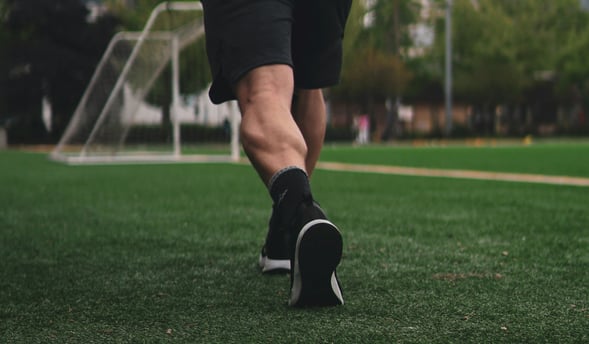How to Actually Grow Your Calves: All the Secrets to Achieving That Diamond Shape
Unlock the secrets to growing your calves and achieving that diamond shape with this in-depth guide. Learn how to structure your workouts for optimal calf development, including tips on exercises, frequency, and recovery to maximize muscle growth.
TRAINING


Growing your calves is often considered one of the most challenging aspects of building an impressive physique. Many people, from fitness enthusiasts to seasoned bodybuilders, struggle to develop their calf muscles despite working them regularly. Achieving that coveted diamond shape—the defined, muscular appearance that many strive for—requires more than just the occasional set of calf raises. It demands the right combination of intensity, consistency, and smart training techniques.
In this article, we will break down the secrets to effectively growing your calves, including the anatomy of the calf muscles, training strategies, and common mistakes to avoid. Whether you're just starting out or have hit a plateau, these tips will help you unlock the potential for real calf growth.
1. Understanding Calf Anatomy: The Key to Smart Training
Before diving into the training methods, it's essential to understand the anatomy of your calf muscles. The calves are made up of two primary muscles:
Gastrocnemius: This is the larger, outer calf muscle that gives the lower leg its bulk. It has two heads (medial and lateral), and it plays a significant role in plantar flexion (pointing the toes downward). The gastrocnemius is most activated during standing calf exercises, especially when the knee is straight.
Soleus: Sitting underneath the gastrocnemius, the soleus is a flatter, longer muscle that helps provide the overall thickness and support to the calf. It’s primarily worked when the knee is bent, such as in seated calf raise exercises.
To develop full, well-rounded calves, it’s crucial to target both the gastrocnemius and the soleus. Many lifters neglect one or the other, leading to incomplete development and frustration.
2. Train Your Calves With High Frequency
One of the most common mistakes people make is training their calves too infrequently. Your calves are used to regular work—every time you walk, run, or go up a flight of stairs, they’re engaged. Because of this, they are more resilient to stress than many other muscle groups and require higher frequency to grow.
How Often Should You Train Calves?
Ideally, aim to train your calves 3-4 times per week. This doesn’t mean you need to dedicate an entire workout session to calves each time. Instead, you can add calf exercises to the end of your leg or upper body workouts. Frequent stimulation is key to getting them to respond and grow.
3. Focus on Full Range of Motion
Using a full range of motion (ROM) is essential for calf development. Many people rush through calf exercises or use a limited ROM, failing to properly engage the muscle fibers. When performing exercises like calf raises, ensure that you:
Start from a Stretch: Lower your heels as far as possible at the beginning of each rep to stretch the calf muscles fully.
Peak Contraction: Press through the balls of your feet and raise your heels as high as possible, focusing on the contraction at the top of the movement.
Controlled Descent: Lower slowly and under control, keeping tension on the muscles throughout the entire movement.
This attention to detail will increase the time under tension (TUT) and force your calves to work harder, leading to better results.
4. Incorporate a Variety of Exercises
Just like any other muscle group, calves respond well to variety. Instead of sticking to the same exercise over and over again, incorporate different movements that target the gastrocnemius and soleus from various angles.
Effective Calf Exercises:
Standing Calf Raises: This classic exercise targets the gastrocnemius and is typically performed with a barbell or machine. Be sure to use a full ROM, as discussed earlier.
Seated Calf Raises: By performing calf raises in a seated position, you shift the focus onto the soleus. This is a crucial exercise for adding thickness and depth to the lower part of the calf.
Donkey Calf Raises: This old-school exercise targets both the gastrocnemius and soleus. Leaning forward while doing calf raises shifts more weight onto your calves, intensifying the contraction.
Single-Leg Calf Raises: Performing calf raises one leg at a time increases the intensity and allows for better muscle isolation. Use bodyweight or hold a dumbbell for added resistance.
Tip: For even more variety, change up the foot positions during your sets. Perform some sets with your toes pointed inward, outward, and straight ahead. This slight variation targets different fibers within the calf muscles.
5. Prioritize Progressive Overload
Calves need consistent progression to grow. Like any other muscle group, they respond to the principle of progressive overload—gradually increasing the resistance or volume of your training over time.
How to Apply Progressive Overload:
Increase Weight: As you grow stronger, aim to progressively increase the weight you're lifting during calf exercises. Start with bodyweight and gradually add weights like dumbbells, barbells, or weight machines.
Add Reps and Sets: If you're not ready to increase the weight yet, add more reps or sets to your routine. Aim for 4-5 sets per exercise with a rep range of 10-20. Calves can handle higher reps, so don’t be afraid to push beyond the typical range.
Increase Time Under Tension: Slow down your reps, especially on the negative portion of the movement, to increase the time under tension. This helps build both strength and muscle mass over time.
6. Don’t Forget Recovery
While training your calves with high frequency is essential, recovery is just as important. Muscle growth happens during rest, not during the workout itself. If you’re training calves 3-4 times a week, make sure you're giving them at least 24-48 hours of recovery between sessions.
Key Recovery Tips:
Get Enough Sleep: Aim for 7-9 hours of sleep per night to support muscle repair and recovery.
Stay Hydrated: Muscles need adequate hydration to function optimally, especially when training frequently.
Nutrition: Make sure you're consuming enough protein and calories to support muscle growth. Aim for 0.7-1 gram of protein per pound of body weight (1.6-2.2 grams per kilogram).
7. Calf Growth Takes Patience
Lastly, remember that calf growth requires patience and consistency. Unlike other muscle groups, calves tend to grow slower due to their daily use in everyday activities. Don’t get discouraged if you don’t see immediate results. Stick to your training plan, focus on proper technique, and allow enough time for recovery. With consistency, your calves will start to show significant improvement.
Conclusion
Growing your calves and achieving that diamond shape requires more than just doing a few sets of calf raises once a week. You need a smart, strategic approach that incorporates frequency, variety, and progressive overload. By targeting both the gastrocnemius and soleus muscles, using a full range of motion, and allowing adequate recovery time, you can finally start seeing the calf growth you've been working towards.


